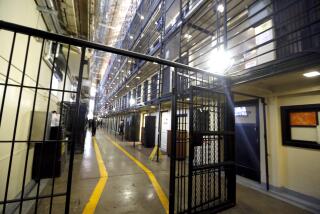State to move at-risk inmates
- Share via
SACRAMENTO — The federal official in charge of healthcare in California prisons has directed that more than 3,000 inmates be moved out of state lockups that are infected with a lethal fungus known as valley fever.
The Monday directive from medical receiver J. Clark Kelso requires state officials to “exclude” especially vulnerable inmates from Pleasant Valley and Avenal state prisons near Coalinga in the Central Valley. The list includes HIV-infected inmates, prisoners with chronic medical conditions, African Americans, Filipinos and others of Asian descent.
“The state of California has known since 2006 that segments of the inmate population were at a greater risk for contracting valley fever,” Joyce Hayhoe, Kelso’s spokeswoman, said Monday. “Immediate steps are necessary to prevent further loss of life.”
Of the more than 8,200 inmates at the two prisons, the medical receiver estimates 40% -- or 3,280 -- must be moved immediately.
It is not clear why certain populations are more prone to the infection than others. But from 2008 to 2010, at least 355 prisoners required hospitalization, and the receiver reported 34 deaths related to valley fever from 2006 to 2011, most of the victims African Americans.
Valley fever is caused by the soil-borne spores of Coccidioides, a fungus common to semiarid regions of the Southwest and Mexico, particularly California’s Central Valley.
Most of those infected suffer no more than a flu-like bout of fever and aches. About 1% develop lethal infections that ravage their bodies.
Health officials say they don’t know whether African Americans are more apt to contract the fungus, or more likely to become seriously ill when they do.
Six months ago, Kelso issued a recommendation that high-risk prisoners no longer be shipped to fever-stricken prisons.
He urged the state to request assistance from the Centers for Disease Control and Prevention.
Last month, spokeswoman Deborah Hoffman said the corrections department was relying on assistance from other state agencies to come up with its own plan to contend with valley fever.
Last week, a state health official wrote to the department of corrections admitting that California is “at a point ... where we need the assistance and expertise” of the center’s disease detectives.
The California Department of Corrections and Rehabilitation had no immediate response to Kelso’s latest directive.
It follows a national expert’s report to federal court alleging that California is ignoring a “public health emergency.”
“I do not understand why CDCR has not yet acted on this recommendation,” Dr. John Galgiani wrote in his report, filed last week. “Prison officials should be, but apparently are not, acting in a manner consistent with a situation where the lives of individuals are at substantial risk.”
Prisoners’ rights lawyers who have been battling the state over conditions in its crowded prisons, meanwhile, filed a motion last month asking U.S. District Judge Thelton Henderson to force officials to protect inmates from the disease.
--
More to Read
Sign up for Essential California
The most important California stories and recommendations in your inbox every morning.
You may occasionally receive promotional content from the Los Angeles Times.














